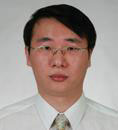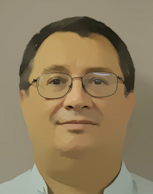| |
 |
|
Professor Alyn Rockwood
King Abdullah University of Science and Technology, Kingdom of Saudi Arabia
http://gmsv.kaust.edu.sa/people/faculty/rockwood/rockwood.html
Dr. Alyn Rockwood is Professor of Applied Mathematics and Associate Director of the Geometric Modeling and Scientific Visualization Research Center at King Abdullah University of Science & Technology (KAUST) in Saudi Arabia – both positions he assumed in June 2009.
Dr. Rockwood has been involved with computer graphics and related research for more than 30 years. At the pioneering graphics company Evans and Sutherland, he led a team that first achieved certification from the U.S. Federal Aviation Administration (FAA) for a pilot training simulator, which allowed pilots to train completely for new aircraft on a simulator. At Silicon Graphics, Inc, he developed the method for rendering curved surfaces in real time that is integral to OpenGL today. These and other innovations led the Association for Computing Machinery's Special Interest Group on Graphics and Interactive Techniques (ACM SIGGRAPH), the premier organization in computer graphics, to appoint him as Research Papers Chair in 1999 and Conference Chair in 2003. Recently, as vice president, he led a multi-million-dollar initiative to create the new conference, SIGGRAPH in Asia. He is currently the SIGGRAPH Asia Papers Chair for 2013.
Before moving to KAUST, Dr. Rockwood held academic positions at both Arizona State University and Colorado School of Mines. He has received several teaching awards, the COFES 2007 Innovation in Technology Award, and the CAD Society "Heroes of Engineering" Award. He has also been the co-founder of three successful startup companies.
His current research is focused on developing new modeling techniques for industrial design and animation, volume meshing for FE analysis, a new basis for image processing, and engineering applications of Clifford Algebra. This work has particular application to terrain modeling and therefore digital reconstruction of historical terrain data.
Dr. Rockwood has published more than 90 peer-reviewed articles, secured six patents, and written three books, including one novel entitled How Noble in Reason. He received his doctorate from the Department of Applied Mathematics and Theoretical Physics at the University of Cambridge in the United Kingdom.
Topic: Curve Based Design [Read Abstract]
|
|
| |
|
|
| |
 |
|
Professor Baoquan Chen
Shenzhen Institutes of Advanced Technology, Chinese Academy of Sciences, China
http://web.siat.ac.cn/~baoquan/
Baoquan Chen is a professor at Shenzhen Institutes of Advanced Technology (SIAT), Chinese Academy of Sciences (CAS); there he directs the Visual Computing Research Center. Prior to that, he was a faculty member at University of Minnesota at Twin Cities. Chen's research interests generally lie in computer graphics, visualization, and user interface. At CAS, he leads effort on developing digital technology for scene acquisition, modeling, and visual analytics, all related to urban environments. Honors and awards include: NSFC Outstanding Young Researcher Award (2010), CAS "One-Hundred Talent" award (2008), IEEE Certificate of Appreciation for Outstanding Service (2006), the IEEE Visualization conference Best Paper Award (2005), the McKnight Land-Grant Professorship at University of Minnesota (2004), National Science Foundation CAREER Award ( 2003), and the recipient of Microsoft Innovation Excellence program (2002). He received his PhD degree in computer science from the State University of New York at Stony Brook in 1999 and a master degree in electronic engineering from Tsinghua University in 1994. .
Topic: Urban Modeling through Laser Scanning [Read Abstract] |
|
| |
|
|
| |
 |
|
Professor Ying He
Nanyang Technological University, Singapore
http://www.ntu.edu.sg/home/yhe/
Ying He is an Associate Professor at School of Computer Engineering, Nanyang Technological University. He received the BS and MS degrees in Electrical Engineering from Tsinghua University, and the PhD degree in Computer Science from the Stony Brook University. His research focuses on geometric computation and analysis that is applied to various engineering fields, including computer graphics, computer-aided design, multimedia, wireless sensor networking and medical imaging. .
Topic: Discrete Geodesic and Its Applications in Digital Geometry Processing [Read Abstract] |
|
| |
|
|
| |
 |
|
Professor Hyeong-Seok Ko
Seoul National University, Seoul, Korea
http://graphics.snu.ac.kr/~ko
Hyeong-Seok Ko is a professor in the Department of Electrical and Information Engineering at Seoul National University. He is the director of Graphics and Media Lab at the same university, and has been developing physically-based techniques for reproducing clothes, hair, deformable solids, and fluids. He recently started Digital Clothing Center, which is a place for developing clothing simulation technology and disseminating the technology to fashion industry. He has contributed to the computer graphics field with technical papers which were published in SIGGRAPH, Eurographics, Pacific Graphics conferences, as well as in the journals including GMOD, ACM TOG, and IEEE TVCG. Recently, he served for SIGGRAPH Asia 2010 as the Conference Chair, which was held on December 15~18, 2010 in Seoul and attracted more than nine thousand attendees. He received B.A. and M.S. degrees in Computer Science from Seoul National University in 1981 and 1985, respectively. He received a Ph.D. degree in Computer and Information Science from University of Pennsylvania.
Topic: Digital Clothing – Interactive Construction and Simulation of Clothes [Read Abstract]
|
|
| |
|
|
| |
 |
|
Professor Ralph Martin
Cardiff University, United Kingdom
http://ralph.cs.cf.ac.uk/
Ralph Martin obtained his PhD in 1983 from Cambridge University. Since then he has been at Cardiff University, where he now holds a Chair and leads the Visual Computing research group. He is also a Guest Professor at Tsinghua and two other Universities in China, and Director of Scientific Programmes of the One Wales Research Institute of Visual Computing. His publications include over 200 papers and 12 books covering such topics as solid modelling, surface modelling, reverse engineering, intelligent sketch input, mesh processing, video processing, computer graphics, vision based geometric inspection, and geometric reasoning. He is a Fellow of the Learned Society of Wales, the Institute of Mathematics and its Applications, and the British Computer Society. He is on the editorial boards of "Computer Aided Design", "Computer Aided Geometric Design", "Geometric Models", and several other journals.
Topic: Noise in 3D Laser Range Scanner Data [Read Abstract] |
|
| |
|
|
| |
 |
|
Professor Nadia Magnenat Thalmann
IMI-NTU, Singapore and MIRALab, University of Geneva, Switzerland
Professor Nadia Magnenat Thalmann has pioneered research into virtual humans over the last 30 years. She obtained several Bachelor's and Master's degrees in various disciplines (Psychology, Biology and Biochemistry) and a PhD in Quantum Physics from the University of Geneva in 1977. From 1977 to 1989, she was a Professor at the University of Montreal in Canada.
Since 1989, she has been a Professor at the University of Geneva where she founded the interdisciplinary research group MIRALab. Her global domain of research is Virtual Humans and Social Robots. She has acquired a great experience of collaborative research through her strong participation to more than 50 European Research Projects. She has coordinated several projects, the most recent one is the Marie Curie Project MUSTISCALE HUMAN.
She is Editor-in-Chief of The Visual Computer Journal published by Springer Verlag, Co- Editor-in-Chief of the journal Computer Animation and Virtual Worlds published by Wiley and Associate Editor of many other scientific journals.
Together with her PhD students, she has published more than 500 papers and books on Virtual Humans and Social Robots with research topics such as 3D clothes, hair, body gestures and emotions modelling, and medical simulation.
She has been invited to give more than 300 keynote lectures in various institutions and organizations, among them the World Economic Forum in Davos. She was Vice-Rector at the University of Geneva from 2003-2006. She is a Member and President of high level international evaluation committees, among the recent ones the Jury of the Vienna Science and Technology Fund, the Advisory Board for Computer Science at Tsinghua University in Beijing, China and the Canada Excellence Research Chairs Review Panel in Ottawa. Very recently, she was on the External Advisory Board of the School of Culture Technology in Kaist in Korea.
During her Career, she has received more than 30 Awards such as “Woman in the Year” in Montreal in 1987. Among the recent ones, she was awarded a Doctor Honoris Causa in Natural Sciences from the Leibniz University of Hanover in Germany in 2009. In May 2010, she received the Distinguished Career Award from the European Association for Computer Graphics in Norrkoping in Sweden and in June 2010, an Honorary Doctorate of the University in Ottawa. In 2012, she has obtained a Career Achievement Award from the Canadian Human Computer Communications Society in Toronto.
She recently received the prestigious Humboldt Research Award in Germany given to “academics whose fundamental discoveries, new theories, or insights have had a significant impact on their own discipline and who are expected to continue producing cutting-edge achievements in the future”.
Besides chairing her research group MIRALab at the University in Geneva, Switzerland, she is presently Director of the Institute for Media Innovation (IMI) at Nanyang Technological University in Singapore..
Topic: Simulating 3D clothes : what about touching them? [Read Abstract] |
|
| |
|
|
| |
 |
|
Professor Brian Wyvill
University of Victoria, Canada
http://webhome.cs.uvic.ca/~blob/
Brian Wyvill graduated from the University of Bradford, Uk with a PhD in computer graphics in 1975. As a post-doc he worked at the Royal College of Art and helped make some animated sequences for the Alien movie. He moved to Canada in 1981 where he has been working in the area of implicit modeling, sometimes with his brother Geoff Wyvill (University of Otago). He is also interested in sketch based modeling, NPR and music, and enjoys combining these areas of research.
Brian spent a quarter of century at the University of Calgary and is now a Professor and Canada Research Chair at the University of Victoria, in British Columbia.
Topic: Efficient Data-Parallel Tree-Traversal for Solid Modeling & Painting with Flowsnakes [Read Abstract] |
|
| |
|
|
| |
|
|
|
|
|
|
